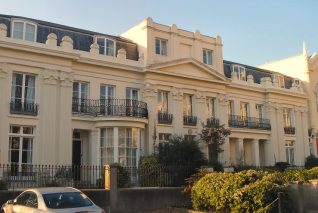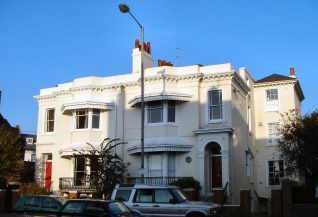Regency




Please note that this text is an extract from a reference work written in 1990. As a result, some of the content may not reflect recent changes and events.
e) REGENCY:
The great expansion of Brighton in the late eighteenth and early nineteenth centuries produced most of the town’s outstanding examples of architecture, and although the Prince of Wales’s regency lasted only from 1811 until 1820, the term ‘Regency-style’ has come to be applied to many of the buildings of the period from around 1810 until the 1840s. Typical are the classical crescents, squares and terraces, adorned with pilasters, ironwork balconies, verandahs and bows. Most are covered in a painted plaster known as ‘stucco’ which resembles stone and gives the town its traditional white and cream appearance; those that remained unstuccoed were usually faced with flint, or with yellow bricks from the former brickfields around the Hove boundary. (The use of stucco was, for many years, considered sham, and it was not until Sitwell and Barton wrote appreciatively of the Regency style in 1935 that general opinion changed {129}.)
Outstanding examples of the Regency style are the classical terraces of the Kemp Town and Brunswick estates; Cavendish Place; Marine Parade; Marine Square; Montpelier Crescent; New Road; Old Steine; Oriental Place; Portland Place; Regency Square; Russell Square; Sillwood Place; and Western Terrace. Excellent examples on a smaller scale may be seen, among others, at the Cricketers Arms, Black Lion Street; Montpelier Street; 79 Preston Street; and 87 London Road.
From the late 1820s until the 1860s a later style was in evidence which retained some elements of the Regency period. Many houses were refronted with newly fashionable wide bows while new houses in this style were erected at Belvedere Terrace; Chesham Place; Chichester Place; Clarendon Terrace; Eastern Terrace; Eaton Place; Grand Parade; Montpelier Road; Norfolk Square; Percival Terrace; Powis Square; and St George’s Place. Attractive Italianate villas were built at Buckingham Place; Clifton Terrace; 128-130 Dyke Road; Montpelier Road; Montpelier Villas; Powis Villas; and Russell Crescent. Less impressive but still attractive contemporary cottages may be found at Blenheim Place; Camden Terrace; Clarence Gardens; Crown Gardens; Crown Street; Dean Street; Frederick Gardens; Hanover Street; Marlborough Street; Norfolk Street; North Gardens; Regent Hill; Spring Street; and Trafalgar Terrace.




No Comments
Add a comment about this page